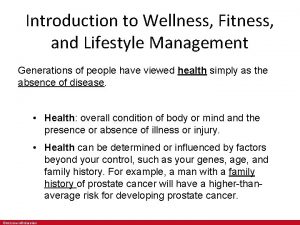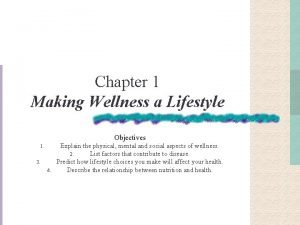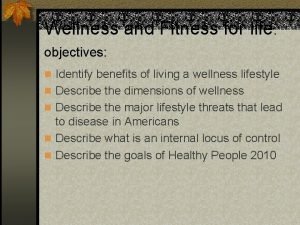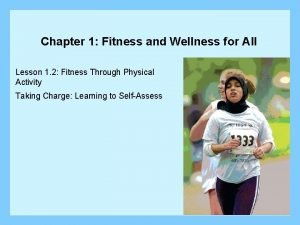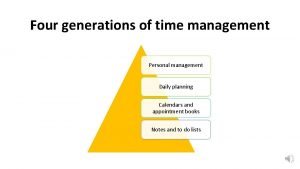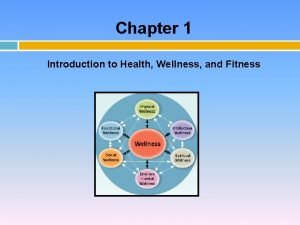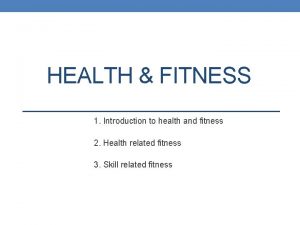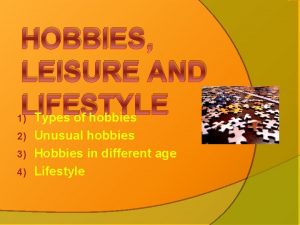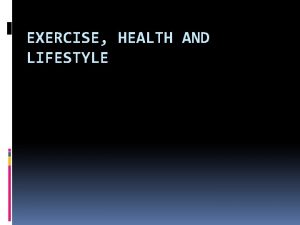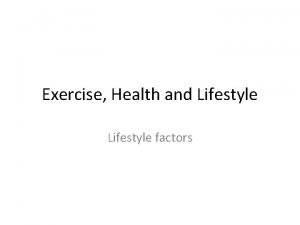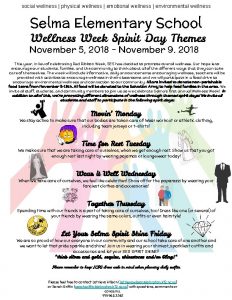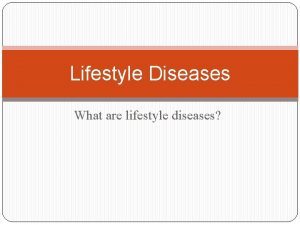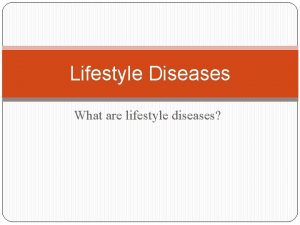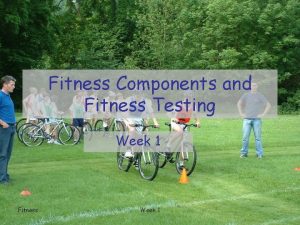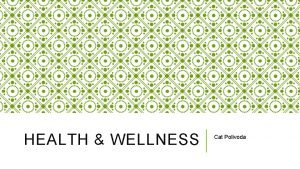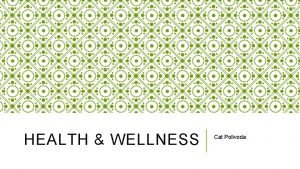Introduction to Wellness Fitness and Lifestyle Management Generations




















































- Slides: 52

Introduction to Wellness, Fitness, and Lifestyle Management Generations of people have viewed health simply as the absence of disease. • Health: overall condition of body or mind and the presence or absence of illness or injury. • Health can be determined or influenced by factors beyond your control, such as your genes, age, and family history. For example, a man with a family history of prostate cancer will have a higher-thanaverage risk for developing prostate cancer. ©Mc. Graw-Hill Education

Introduction to Wellness, Fitness, and Lifestyle Management Wellness expands the idea of health to include the ability to achieve optimal health. Wellness is largely determined by the decisions you make about how you live. That same man(example given in previous slide) can reduce his risk of cancer by eating sensibly, exercising, and having regular screening tests. Even if he develops the disease, he may still reduce its effects and live a rich, meaningful life. Wellness, therefore, involves making conscious decisions to control risk factors (a condition that increases one’s chances of disease or injury). Awareness of potential risk can help you make decisions about prevention and intervention of health behaviors ©Mc. Graw-Hill Education

Dimensions of Wellness Physical Cultural Intellectual Environmental Emotional Spiritual Interpersonal Financial Occupational Each dimension affects the others. The process of achieving wellness is constant and dynamic involving change and growth. Ignoring any dimension of wellness can have harmful effects on your life. Thus, wellness is cumulative. ©Mc. Graw-Hill Education

Dimensions of Wellness Physical wellness Your physical wellness includes not just your body’s overall condition and the absence of disease but also your fitness level and your ability to care for yourself. To achieve optimum physical wellness, you need to make choices that help you avoid illnesses and injuries ©Mc. Graw-Hill Education

Dimensions of Wellness Emotional wellness Your emotional wellness reflects your ability to understand deal with your feelings. Emotional wellness involves attending to your own thoughts and feelings, monitoring your reactions, and identifying obstacles to emotional stability. Self-acceptance is your personal satisfaction with yourself, which might exclude society’s expectations, whereas self-esteem relates to the way you think others perceive you. Self-confidence can be a part of both acceptance and esteem. ©Mc. Graw-Hill Education

Dimensions of Wellness Intellectual wellness requires challenging your mind(brain). An active mind is essential to wellness because it detects problems and finds solutions. People who enjoy intellectual wellness never stop learning. They seek out and relish new experiences and challenges. ©Mc. Graw-Hill Education

Dimensions of Wellness Interpersonal wellness Satisfying and supportive relationships are important to physical and emotional wellness. Learning good communication skills, developing the capacity for intimacy, and cultivating a supportive network are all important to interpersonal (or social) wellness. Social wellness requires participating in and contributing to your community and to society. ©Mc. Graw-Hill Education

Dimensions of Wellness Cultural wellness The way you interact with others who are different (diverse)from you in terms of ethnicity, religion, gender, sexual orientation, age, and customs (practices). It involves creating relationships with others and suspending judgment on others’ behavior until you have lived with them or shared part of their life experience It also includes accepting, valuing, and even celebrating the different cultural ways people interact in the world. The extent to which you maintain and value cultural identities is one measure of cultural wellness ©Mc. Graw-Hill Education

Dimensions of Wellness Spiritual wellness To possess a set of guiding beliefs, principles, or values that give meaning and purpose to your life. The well person uses spirituality to focus on positive aspects of life and to fend off negative feelings such as cynicism, anger, and pessimism. Organized religions help many people develop spiritual health. Religion, however, is not the only source or form of spiritual wellness. Many people find meaning and purpose in their lives on their own through nature, art, meditation, good works, or with their loved ones ©Mc. Graw-Hill Education

Dimensions of Wellness Environmental wellness Defined by the “livability” of your surroundings. Your own personal health depends on the health of the planet ranging from the safety of the food supply to the degree of violence in society. To improve your environmental wellness, you can learn about and protect yourself against hazards in your surroundings and work to make your world a clea. ner and safer place ©Mc. Graw-Hill Education

Dimensions of Wellness Financial wellness Is your ability to live within your means and manage your money in a way that gives you peace of mind. It includes balancing your income and expenses, staying out of debt, saving for the future, and understanding your emotions related to money. See TAKE CHARGE “Financial Wellness”, p. 5 text for additional tips and guidance on financial wellness. ©Mc. Graw-Hill Education

Dimensions of Wellness Occupational wellness refers to the level of happiness and fulfillment you gain through your work. High salaries alone do not bring about occupational wellness. An occupationally well person likes work, feels a connection with others in the workplace, and takes advantage of opportunities to learn and be challenged. An ideal job draws on your interests and passions, skills, and allows you to feel that you are making a contribution. ©Mc. Graw-Hill Education

Dimensions of Wellness Reflection: 1) List a dimension of wellness where you have “strengths”. What particular components of the dimension (ex. Physical Wellness: Muscle Strength, Endurance) 2) Now list a dimension of wellness that you think you could make some real improvements, but have not been able or unwilling to do. 3) How do you think your “strengths” might be used to help areas where you can make improvements. In other words how could you use on dimension of wellness to improve another? ©Mc. Graw-Hill Education

Life Quality and Life Expectancy Life expectancy has nearly doubled since 1850. In 1850, infectious disease (examples: pneumonia, tuberculosis, or diarrhea) and poor environmental conditions shortened many lives. Public health achievements during the 20 th century are credited with adding more than 25 years to life expectancy for Americans, greatly improving quality of life, and dramatically reducing deaths from infectious diseases. ©Mc. Graw-Hill Education

Life Quality and Life Expectancy By 2015, however, life expectancy nearly doubled, to 78. 8 years This increase in life span is due largely to the development of vaccines and antibiotics to fight infections, and to public health measures to improve living conditions. Even though life expectancy has increased, poor health limits most Americans’ activities during the last 10– 15% of their lives, resulting in some sort of life impairment. ©Mc. Graw-Hill Education

Life Quality and Life Expectancy Presently, a different set of diseases has emerged as our major health threat: Heart disease, cancer, and chronic lower respiratory diseases are now the three leading causes of death for Americans (see charts that follow) In fact, life expectancy has now began to decline again in the United States because of chronic health conditions that are linked to lifestyle choices. Chronic disease: disease that develops and continues over a long period of time. Lifestyle choices: conscious behavior that can increase or decrease a person’s risk of disease or injury. ©Mc. Graw-Hill Education

Leading Causes of Death in the United States, 2012 RANK ©Mc. Graw-Hill Education CAUSE OF DEATH PERCENTAGE OF TOTAL DEATHS NUMBER OF DEATHS LIFESTYLE FACTORS THAT PLAY A PART 1 Heart disease 633, 842 23. 4 Diet, inactivity, smoking, excessive alcohol use, obesity 2 Cancer 595, 930 22. 0 Diet, inactivity, smoking, excessive alcohol use, obesity 3 Chronic lower respiratory diseases 155, 041 5. 7 Diet, inactivity, smoking, obesity 4 Unintentional injuries 146, 571 (accidents) 5. 4 Inactivity, smoking, excessive alcohol use 5 Stroke 140, 323 5. 2 Diet, inactivity, smoking, excessive alcohol use, obesity 6 Alzheimer’s disease 110, 561 4. 1 Inactivity, smoking

Leading Causes of Death in the United States, 2012 RANK CAUSE OF DEATH PERCENTAGE OF TOTAL DEATHS NUMBER OF DEATHS LIFESTYLE FACTORS THAT PLAY A PART 7 Diabetes mellitus 79, 535 2. 9 Diet, inactivity, smoking, excessive alcohol use, obesity 8 Influenza and pneumonia 57, 062 2. 1 Smoking, excessive alcohol use 9 Kidney disease 49, 959 1. 8 Diet, smoking, excessive alcohol use, obesity 10 Intentional self-harm 44, 193 (suicide) 1. 6 Excessive alcohol use All causes 100. 0 2, 712, 630 NOTE: Although not among the overall top 10 causes of death, HIV/AIDS (6, 465 deaths in 2015) is a major killer. In 2015, HIV/AIDS was the 13 th leading cause of death for Americans aged 15 to 24 years and the 9 th leading cause of death for those aged 25 to 34 years. SOURCE: Centers for Disease Control and Prevention. 2017. 10 Leading Causes of Death by Age Group, United States, 2015. Webbased Injury Statistics Query and Reporting System (www. cdc. gov/injury/wisqars); Centers for Disease Control and Prevention. 2016. Cause of Death 1999 -2015 on CDC WONDER Online Database (http: //wonder. cdc. gov/ucd-icd 10. html). ©Mc. Graw-Hill Education

National Health and Coverage Average annual health expenditures in the U. S. are the highest in the world: $10, 000 person in 2016. These costs are not distributed evenly across individuals, and people's healthcare costs may vary significantly from year to year. People without insurance are less likely to receive preventive care or treatment for major health problems The 2010 Affordable Care Act (ACA), was enacted to both reduce the number of uninsured and control the rise in healthcare costs. It has been debated that the ACA reduces reduced the number of people without insurance, slowed the rise in health care costs and increased quality of care. Others cite higher premiums and fewer insurance options as reasons to repeal and replace some or all of the law. ©Mc. Graw-Hill Education

National Health Initiaves Healthy People Initiatives The National Healthy People initiative aims to prevent disease and improve Americans’ quality of life. Healthy People reports, published each decade since 1980, set national health goals based on 10 -year agendas. These initiatives focus on: • Prevent disease, disability, injury, and premature death • Achieve health equity, eliminate disparities, and improve health of groups • Create social and physical environments that promote good health • Promote healthy behaviors for every stage of life ©Mc. Graw-Hill Education

National Health Initiatives Healthy People 2020 Initiatives: 1) Eliminate preventable disease, disability, injury, and premature death. This objective involves taking more concrete steps to prevent diseases and injuries, promoting healthy lifestyle choices, improving the nation’s preparedness for emergencies, and strengthening the public health infrastructure. 2) Achieve health equity, eliminate disparities, and improve the health of all groups. This objective involves identifying, measuring, and addressing health differences between individuals or groups that result from social or economic disadvantage. ©Mc. Graw-Hill Education

National Health Initiatives Healthy People 2020 Initiatives: 3) Create social and physical environments that promote good health for all. This objective involves the use of health interventions at many levels (such as anti-smoking campaigns by schools, workplaces, and local agencies), providing a broader array of educational and job opportunities for undereducated and poor Americans, and actively developing healthier living and natural environments for everyone. 4) Promote healthy development and healthy behaviors across every stage of life. This goal involves taking a cradle-to-grave approach to health promotion by encouraging disease prevention and healthy behaviors in Americans of all ages. ©Mc. Graw-Hill Education

National Health Initiatives In a shift from the past, Healthy People 2020 emphasizes the importance of health determinants—factors that affect the health of individuals, demographic groups, or entire populations. Health determinants are social (including factors such as ethnicity, education level, and economic status) and environmental (including natural and human-made environments). Thus, one goal is to improve living conditions in ways that reduce the impact of negative health determinants. Presently, there is planning and development for Healthy People 2030. ©Mc. Graw-Hill Education

Health Determinants and Wellness Reflection: 1) How does improving social determinants of health (including factors such as ethnicity, education level, and economic status) as defined in Healthy People 2020 promote improvements in different dimensions of personal wellness? Give specific examples. 2) Likewise, how could a negative change in social determinants of health increase the risk that someone’s wellness behavior may change into behaviors that are unhealthy Give specific examples. ©Mc. Graw-Hill Education

Behaviors That Contribute to Wellness Be physically active • Physical fitness: set of physical attributes that allow the body to respond to or adapt to demands and stress of physical effort • Sedentary: physically inactive ©Mc. Graw-Hill Education Benefits of Physical Activity

Behaviors That Contribute to Wellness Choose a healthy diet Many Americans have a diet that is too high in calories, unhealthy fats, and added sugars, as well as too low in fiber, complex carbohydrates, fruits, and vegetables. A healthy diet provides necessary nutrients and sufficient energy without also providing too much of the dietary substances linked to diseases. ©Mc. Graw-Hill Education

Behaviors That Contribute to Wellness Maintain a healthy body weight Overweight and obesity are associated with a number of disabling and potentially fatal conditions and diseases, including heart disease, cancer, and type 2 diabetes. Maintaining a healthy weight requires a lifelong commitment to regular exercise, a healthy diet, and effective stress management. ©Mc. Graw-Hill Education

Behaviors That Contribute to Wellness Manage stress effectively Over longer periods of time, poor stress management can lead to less efficient functioning of the immune system and increased susceptibility to disease. Learning to incorporate effective stress management techniques into daily life is an important part of a fit and well lifestyle. ©Mc. Graw-Hill Education

Behaviors That Contribute to Wellness Avoid tobacco and drug use, and limit alcohol consumption Tobacco use is associated with 9 of the top 10 causes of death in the United States; personal tobacco use and secondhand smoke kill nearly 500, 000 Americans each year. Excessive alcohol consumption is linked to 8 of the top 10 causes of death and results in about 90, 000 deaths a year in the United States. ©Mc. Graw-Hill Education

Behaviors That Contribute to Wellness Protect yourself from disease and injury The most effective way to dealing with disease and injury is to prevent them. You can take specific steps to avoid infectious diseases, particularly those that are sexually transmitted. ©Mc. Graw-Hill Education

Behaviors That Contribute to Wellness Take other steps toward wellness: • Develop meaningful relationships –communication skills, dealing with emotions, listening and social skills • Plan for successful aging – anticipating upcoming physical and financial challenges, remaining engaged with others. • Learn about the health care system- learning how to navigate the health care system and which treatment options are available to you. • Act responsibly toward the environment – reducing carbon footprint, recycling and protecting resources, renewable energy, etc. ©Mc. Graw-Hill Education

Wellness Factors That Seem Outside Our Control Heredity, the environment, and adequate health care other important influences on health and wellness. A sedentary lifestyle combined with a genetic predisposition can greatly increase a person’s risk of developing the disease. (controllable vs, non-controllable risk factors) Behavior can tip the balance toward health even if heredity or environment is a negative factor. ©Mc. Graw-Hill Education

College Students and Wellness According to the fall 2016 American College Health Association National College Health Assessment Two, the most commonly reported factors affecting academic performance among college students are stress, anxiety, sleep difficulties, depression, work, illness (cold/flu/sore throat), concern for a trouble friend/family member, and Internet use/computer games. Each of these factors is related to one or more dimensions of wellness, and most can be influenced by choices students make daily. How do your daily wellness choices compare to those of other students? ©Mc. Graw-Hill Education

Reaching Wellness through Lifestyle Management Behavior change: lifestyle management process that involves cultivating healthy behaviors and working to overcome unhealthy ones Moving in the direction of wellness means cultivating healthy behaviors and working to overcome unhealthy ones. Getting Serious about Your Health Before you can start changing a wellness-related behavior, you have to know that the behavior is problematic and that you can change it. Examine Your Current Health Habits Consider how your current lifestyle is affecting your health today. How will it affect your health in the future? Talk with friends and family members about what they’ve noticed about your lifestyle and your health. ©Mc. Graw-Hill Education

Reaching Wellness through Lifestyle Management Choose a Target Behavior Start small by choosing one behavior you want to change—called a target behavior—and working on it until you succeed. Your chances of success will be greater if your first goal is simple, such as resisting the urge to snack between classes, if you goal is to lose weight. Learn about Your Target Behavior After you’ve chosen a target behavior, you need to learn its risks and benefits for you—both now and in the future. Assess how the target behavior is affecting your level of wellness, the diseases or conditions this behavior places you at risk for, and how changing your behavior can improve your health. Find Help Don’t be discouraged by the seriousness or extent of the problem; many resources are available to help you solve it. ©Mc. Graw-Hill Education

Building Motivation to Change Examine the pros and cons of change Consider the benefits and costs of an inactive lifestyle: In the short-term, it allows you more time to watch TV and hang out with friends, but it leaves you less fit and less able to participate in recreational activities. In the long-term, this lifestyle increases the risk of heart disease, cancer, stroke, and premature death. Carefully examine the pros and cons of continuing your current behavior and of changing to a healthier one. Short-term benefits of behavior change can be an important motivating force. In your mind, benefits must outweigh costs ©Mc. Graw-Hill Education

Building Motivation to Change Boost self-efficacy Self-efficacy refers to your belief in your ability to successfully take action and perform a specific task. Locus of control refers to the figurative “place” (internal or external) a person designates as a source of responsibility for the events in his or her life. For lifestyle management, an internal locus of control is an advantage because it reinforces motivation and commitment. If you find yourself attributing too much influence to outside forces, gather more information about your wellness-related behaviors. ©Mc. Graw-Hill Education

Building Motivation to Change Building Self-Efficacy continued… One of the best ways to boost your confidence and selfefficacy is to visualize yourself successfully engaging in new, healthier behavior. You can also use self-talk, the internal dialog you carry on with yourself, to increase your confidence in your ability to change. Social support in the form of role models and other supportive individuals can make a big difference in your level of motivation and your chances of success. ©Mc. Graw-Hill Education

Building Motivation to Change Identify and Overcome Barriers to Change Make a list of the problems and challenges you faced in any previous behavior change attempts. After you’ve listed these key barriers to change, develop a practical plan for overcoming each one. ©Mc. Graw-Hill Education

Building Motivation to Change Enhancing Your Readiness to Change: Behavior Change Model 1. Precontemplation People at this stage do not think they have a problem and do not intend to change their behavior. 2. Contemplation People at this stage know they have a problem and intend to take action within six months. 3. Preparation People at this stage plan to take action within a month or may already have begun to make small changes in their behavior ©Mc. Graw-Hill Education

Building Motivation to Change Enhancing Your Readiness to Change: Behavior Change Model 4. Action During the action stage, people outwardly modify their behavior and their environment. This requires the greatest commitment of time and energy, and people in this stage are at risk for reverting to old, unhealthy patterns of behavior. 5. Maintenance People at this stage have maintained their new, healthier lifestyle for at least six months. 6. Termination People at the termination stage have exited the cycle of change and are no longer tempted to lapse back into their old behavior. ©Mc. Graw-Hill Education

Behavior Change Model ©Mc. Graw-Hill Education

Dealing with Relapse Research suggests that most people make several attempts before they successfully change a behavior; four out of five people experience some degree of backsliding. If you experience a lapse or a relapse, follow these steps: a. Forgive yourself. b. Give yourself credit for the progress you have already made. c. Move on. ©Mc. Graw-Hill Education

Developing Skills for Change: Creating a Personalized Plan 1. Monitor your behavior and gather data. Keep a record of your target behavior and the circumstances surrounding it. 2. Analyze the data and identify patterns. Note the connections between your feelings and such external cues as time of day, location, situation, and the actions of others around you. ©Mc. Graw-Hill Education

Developing Skills for Change: Creating a Personalized Plan Be “SMART” about setting goals. Your behavior change goals should be: Specific. Avoid vague goals like “eat more fruits and vegetables. ” Measurable: Give your goal a number. Attainable: Set goals that are within your physical limits. Realistic: Manage your expectations when you set goals. Time frame-specific: Give yourself a reasonable amount of time to reach your goal, state the time frame in your behavior change plan, and set your agenda to meet the goal within the given time frame. You may not be able to meet these goals, but you never know until you try. For some goals and situations, it may make more sense to focus on something other than your outcome goal. ©Mc. Graw-Hill Education

Developing Skills for Change: Creating a Personalized Plan Devise a plan of action: Develop a strategy that will support your efforts to change. 1) Get what you need. Identify resources that can help you. 2) Modify your environment. If you have cues in your environment that trigger your target behavior, try to control them. 3) Control related habits. You may have habits that contribute to your target behavior; modifying these habits can help change the behavior. 4) Reward yourself. Plan your rewards, and tie rewards to achieving specific goals or sub-goals. 5) Involve the people around you. Ask family and friends to help you with your plan. 6) Plan for challenges. Think about situations and people that might derail your program and develop ways to cope with them. ©Mc. Graw-Hill Education

Developing Skills for Change: Creating a Personalized Plan Make a personal contract. A serious personal contract can result in a higher chance of follow-through than a casual, offhand promise. Include a starting date, steps to measure progress, strategies to promote change, and a date to complete the goal. ©Mc. Graw-Hill Education

FIGURE 1. 7 — Sample Health Journal Entries Access the text alternative for slide images ©Mc. Graw-Hill Education

Putting Your Plan into Action This stage requires commitment, the resolve to stick with the plan no matter what temptations you encounter. Use all your strategies to make your plan work. Staying With The Plan Don’t be surprised when you run up against obstacles; they’re inevitable. Feel free to make some changes before going on. Obstacles may come from a variety of sources. Social Influences Take a hard look at the reactions of the people you’re counting on, and see if they’re really supporting you. ©Mc. Graw-Hill Education

Staying With The Plan Levels of Motivation and Commitment If commitment is your problem, you may need to wait until the behavior you’re dealing with makes you unhappier or unhealthier; then your desire to change it will be stronger. Choice of Techniques and Level of Effort If your plan is not working as well as you thought it would, make changes where you’re having the most trouble. Stress Barrier If you hit a wall in your program, look at the sources of stress in your life. Procrastinating, Rationalizing, and Blaming Be alert to games you might be playing with yourself, so you can stop them. Such games include the following: Procrastinating: If you tell yourself, “It’s Friday already; I might as well wait until Monday to start, ” you’re procrastinating. Break your plan into smaller steps that you can accomplish one day at a time. ©Mc. Graw-Hill Education

Staying With The Plan Procrastinating, Rationalizing, and Blaming Rationalizing: If you tell yourself, “I wanted to go swimming today but wouldn’t have had time to wash my hair afterward, ” you’re making excuses. Blaming: If you tell yourself, “I couldn’t exercise because Dave was hogging the elliptical trainer, ” you’re blaming others for your own failure to follow through. ©Mc. Graw-Hill Education

Being Fit and Well for Life • Your first attempts at making behavior changes may never go beyond the contemplation or preparation stage. But as you experience some success, you’ll start to have more positive feelings about yourself. • Once you’ve started, don’t stop. Assume that health improvement is forever. • Take on the easier problems first, and then use what you learn to tackle more difficult problems later. End Chapter One ©Mc. Graw-Hill Education
 Introduction to wellness and fitness
Introduction to wellness and fitness Wellness and lifestyle management
Wellness and lifestyle management Making wellness a lifestyle
Making wellness a lifestyle Fitness is a lifestyle
Fitness is a lifestyle Stairway to lifetime fitness health and wellness
Stairway to lifetime fitness health and wellness Fitness - chapter 1
Fitness - chapter 1 Objectives of fitness and wellness
Objectives of fitness and wellness Stairway to lifetime fitness health and wellness
Stairway to lifetime fitness health and wellness As you climb the stairway to lifetime fitness
As you climb the stairway to lifetime fitness Pure fitness and wellness
Pure fitness and wellness Skill related fitness vs health related fitness
Skill related fitness vs health related fitness Fitness vs wellness
Fitness vs wellness Four generations of time management
Four generations of time management Introduction of health and fitness
Introduction of health and fitness Ability to use voluntary muscles repeatedly without tiring
Ability to use voluntary muscles repeatedly without tiring A plant's life cycle alternates between and generations.
A plant's life cycle alternates between and generations. Plant life cycles and alternation of generations
Plant life cycles and alternation of generations Lifestyle modern
Lifestyle modern Jamaica health and lifestyle survey
Jamaica health and lifestyle survey Hobbies leisure and lifestyle
Hobbies leisure and lifestyle Global fashion logistics
Global fashion logistics Attempts to develop quantitative measures of lifestyle
Attempts to develop quantitative measures of lifestyle Unit 14 exercise health and lifestyle
Unit 14 exercise health and lifestyle Spartan lifestyle and values
Spartan lifestyle and values Exercise health and lifestyle
Exercise health and lifestyle Exercise health and lifestyle
Exercise health and lifestyle Leisure time hobbies
Leisure time hobbies Todays generations
Todays generations Three generations of packet switches
Three generations of packet switches Wet bonding vs dry bonding
Wet bonding vs dry bonding Generations in a pedigree
Generations in a pedigree Generations in a pedigree
Generations in a pedigree Future generations collaborative
Future generations collaborative Alternation of generations ferns
Alternation of generations ferns Generations overview
Generations overview Four generations of ethernet
Four generations of ethernet Alternation of generations in plants
Alternation of generations in plants Inspire future generations
Inspire future generations Metabolisem
Metabolisem Generations
Generations Let's preserve it for future generations
Let's preserve it for future generations Generations in order
Generations in order What does 1st generation mean
What does 1st generation mean 1995 generation
1995 generation Ethernet evolution through four generations
Ethernet evolution through four generations Come lord jesus come and be born in our hearts lyrics
Come lord jesus come and be born in our hearts lyrics 4th generation of computer
4th generation of computer Mukta desai
Mukta desai Three generations of multicomputers
Three generations of multicomputers Rotary international
Rotary international Carolina morales iribarren
Carolina morales iribarren Overlapping generations model
Overlapping generations model Generations of supraglottic airway devices
Generations of supraglottic airway devices
